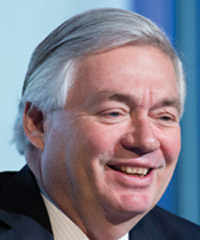News Backgrounder
Battle stations
The B787 Dreamliner has put its battery problem to bed and the A350-9 has made its maiden flight. The gloves are now off as Boeing and Airbus vie for the lead with their latest competing models in the long-haul market.
July 1st 2013
Lessons learned
 |
| 'The lessons learned [on the B787] are that we are not going to make the same mistakes again' |
| John Wojick Senior Vice-President Global Sales Boeing |
Boeing has had many apologies to make in recent years to its Dreamliner customers, not only for the three year delivery delays, but for the more recent drama of the B787’s grounding with battery problems. But John Wojick, Boeing’s senior vice-president global sales, says the setbacks are not impacting on the order book.
“In fact, last year was Boeing’s second best 12 months on record for orders, and 2013 is shaping up to be a relatively strong year as well,” he said. “We had 503 orders by the end of May and the strong demand continues.”
At the Paris Air Show in June, Boeing had orders and commitments for 442 additional aircraft. Firm net orders at the end of June stood at 690 aircraft for the year.
He made it clear there were “a tremendous” number of lessons learned from the B787 programme.
“Clearly, we made mistakes and it cost us dearly,” said Wojick. “It has impacted our customers and that’s the toughest part. We failed in providing what we promised in terms of delivering on time.
“The nice thing is the plane is back in service and is delivering the capabilities that we promised. The passenger response to the aircraft has been extremely positive.
“The lessons learned are that we are not going to make the same mistakes again on any future development programme.”
Japan Airlines chairman, Masaru Onishi, told Orient Aviation during last month’s International Air Transport Association annual general meeting in Cape Town that he had feared Japan’s notoriously sensitive flying public would shy away from B787 services after its return to the skies.
“But from our bookings there have been no such indications. For example, our flights to San Diego, Boston and Singapore are nearly full,” he said.
Meanwhile, Wojick is adamant the battery issue has been resolved, even though the root cause of the initial problem has not been identified.
“We have addressed all of the items that we believe could have caused this impact on the batteries. We have not just put big metal cases around them, but we have addressed all the potential root causes that we can fathom on the batteries,” he said.
“There is absolutely no ability for that battery to impact the aircraft and the safety of flight of the plane.”
At the end of June there were 66 B787s in service – 930 have been ordered. The Boeing sales team is working on more orders, as well as the launch of the new 300-seat B787-10.
Wojick believes Boeing is well prepared to meet competition from Airbus with its new A350 series.
“We have approached our widebody strategy in a very disciplined way,” he said. “With the B787 we are addressing the market from about 220 seats to about 300 seats with three planes, the -8, the -9 and soon the -10. With those products we are able to serve every 10% to 15% increase in passenger capability.
“To address the next size category, which is 350 seats to around 400 seats, we’re looking at the future of the B777 family. The planes we are considering for 2020 and beyond are the B777-8X, a 350-seat plane, and the B777-9X, a 406 seat plane in tri-class.
“We’re in discussions with carriers around the world on both these planes. We hope to have more detailed discussions in second half of the year.”
When it comes to high capacity aircraft, where Boeing pits its B787-8 Intercontinental against the Airbus’ A380, Wojick still thinks his competitor has got its numbers wrong.
“We believe there is demand for large planes, but we differ with our competitor on the size of the demand. We predict 750 of these planes will be required in the next 20 years [Airbus forecasts around 1,330].
That’s 35-40 planes a year that need to be built. That is where the supply and demand balance really is and we’re adjusting our production rates accordingly.
“Are we going to sell thousands of them like we have the B787? No. But it’s a market segment we want to serve and we think we can be quite successful in it.”
Leahy cranks up the mind games
 |
| 'We are taking a very conservative approach [to the A350] and that’s why you saw no formal roll out and no big announcement about its first flight' |
| John Leahy Chief Operating Officer, Customers Airbus |
Sitting in the Airbus hospitality lounge in Cape Town’s Westin Hotel, a short stroll from the venue of the International Air Transport Association (IATA) annual general meeting last month, Airbus’ long-serving and outspoken chief operating officer, customers, John Leahy, was showing no signs of mellowing with age.
Rival Boeing, he said, had always been known as the paper aeroplane maker. It is what he believes Seattle’s newest plane on the drawing board, the B777X, will become.
Approved by the Boeing board in late April, the 353-407 seat B777X, which will feature larger composite wings and new GE9X engines, is the response to Airbus’ planned 350-seat A350-1000.
A few weeks later, as Airbus’ new A350-9 took to the skies above Toulouse for the first time last month the European planemaker’s master salesman was sharpening his verbal skills in preparation for what promises to be a major dogfight to win orders in the long-haul jet market.
With the smaller A350-9 coming into service next year and its current A330 still selling well, the Airbus medium to long-haul family will be pitted against the existing B777, the B787 Dreamliner and the planned B777X.
Airbus hopes its products will finally win it a significant breakthrough in the long Boeing-dominated Japanese market. Both All Nippon Airways chief executive, Osamu Shinobe, and Japan Airlines chairman, Masaru Onishi, have said recently they are studying the A350.
“They (Boeing) love to produce paper aeroplanes. I would suggest that the Japanese remember the Sonic Cruiser. I would suggest that they also remember the B747-500, the B747-600, the B787-3, and the B777-200 with folding wings that was sold to people around the world, but never saw the light of day,” he told Orient Aviation.
“The A350-1000’s limitation is not the 777X, it’s our own production capability. If I could double production I’d sell them.”
Leahy was speaking as the European airframe manufacturer released its latest sales figures, which showed a sparkling start to the year for Airbus. After losing the sales lead to Boeing in 2012 for the first time in a decade – it had net orders of 833 aircraft (after cancellations) compared with Boeing’s 921 – it had regained the lead between January and May this year.
It booked 517 orders against Boeing’s 498 in the five month period. Airbus had orders and commitments for 466 more aircraft at the Paris Show. Of these 241 had been booked as firm orders by the end of June. After cancellations, Airbus’ order intake for the first six months stood at 722 aircraft, not far short of its annual projection of more than 800. It has a backlog of nearly 4,700 planes, worth $638 billion.
These days Toulouse is taking a more cautious approach to the launch of new aircraft types. Leahy said lessons had been learned from the delays of the A380 and Boeing’s Dreamliner, as well as the 787’s subsequent battery problems.
“We are taking a very conservative approach [to the A350]. That’s why you saw no formal roll out and no big announcement about its first flight,” said Leahy.
“The economics will be the game changing part of our airplane.”
Leahy also reacted strongly to suggestions that sales of the A380 have tailed off badly - only nine were sold last year – and projections that large capacity aircraft sales were off the mark.
“I absolutely disagree. We said we would sell around 25 aircraft this year. We’ll produce around 25 airplanes this year. It is a very stable programme and I stick by that target. We’ve got quite a few A380 sales campaigns underway,” he said.
He pointed out that forecasts from IATA, Airbus, Boeing and engine manufacturers agree traffic will double in the next 15 years. “So how are we going to double the number of flights to Singapore, Heathrow, CDG [Paris] or JFK [New York]? It is impossible. Unless those airports are going to become secondary airports you are guaranteed to need bigger aircraft,” he said.
A number of the sales campaigns are in Asia, said Leahy, and at least one of the region’s carriers, Malaysia Airlines, has signalled a further order this year. It currently has six A380s.
Chief executive, Ahmad Jauhari Yahya, said last month it may order “a few more” and would make a decision by year-end.
Leahy is confident U.S. carriers, which have not ordered A380s to date, will also buy the plane. “Virtually every big airline on Pacific routes is flying A380s into the U.S. It’s only a matter of time before the U.S. airlines are going to have to respond by buying A380s,” he said.
| Tianjin upgrade for neo Meanwhile, Airbus has been undergoing a transformation under the leadership of its chief executive, Fabrice Bregier, who took charge a year ago. “What we are trying to do … is look for further growth,” said Bregier, speaking at an Innovation Day for the world’s media in Toulouse last month. He wants a stable 10% profit margin by 2015. Bregier wants Airbus “internationalized”. He said it would look for further opportunities to broaden its “on the ground” presence outside Europe. This strategy could include more manufacturing joint ventures modelled on its A320 final assembly line in Tianjin, China, and the new factory at Mobile, Alabama, which will produce an A320 every week from 2017. Bregier said: “We are very open. We have demonstrated the Tianjin model works.” He suggested the Tianjin line would be upgraded to produce the A320neo. He said Airbus was placing a great deal of focus on reducing technical risks in its development of new aircraft. The company’s various divisions were better integrated. It was a lack of communication between Airbus divisions in France and Germany that led to the three year delay in A380 deliveries. “We now have harmonized ways of working. We have people that change between Toulouse and Hamburg and other places,” said Bregier. “We needed to enhance the culture of accountability and we have done that with a change in the organization.” The next challenge, he said, was to simplify the highly technological nature of the business. “We have to enhance the entrepreneurial spirit of our people. I want to change the culture and mindset of our people, to be very open to other ideas and to be much faster in screening those ideas and implementing them,” said the Airbus chief. |